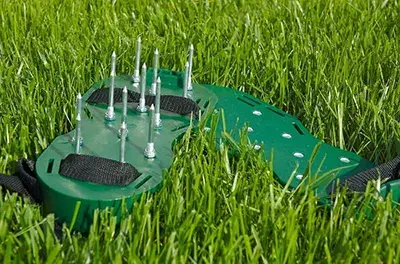Armyworms are destructive lawn pests.
There are four types of army worm that eat grass in Central Texas. 
Photo credit: Texas AgriLife Extension
- Fall armyworm
- Yellow-striped armyworm
- Beet armyworm
- Regular armyworm
The fall armyworm is usually the one that causes the most problems for your lawn. In this article, we’ll learn more about fall army worms, their habits, and how to get rid of army worms.
What do army worms look like?
Contrary to the name, army worms are caterpillars. They’re about 1 ¾ inches long. They are most active at night and tend to hide underneath garden and lawn debris during the day.
Fall army worms, the ones that cause the most havoc in Texas lawns, are brown with yellow stripes.
They get their name because they travel in small insect packs, marching along like little armies and consume just about everything in their path (like the football field pictured below…that was devoured in about three days!).
How do I detect army worms in my lawn?

photo credit: Texas AgriLife Extension
First of all, if you know what type of grass you have, you’re one step closer to identifying the problem. These insects typically appear on buffalograss, fescue, ryegrass and bluegrass.
The earlier you detect army worms, the easier it is to treat your lawn for them. Since they are a night creature, you have to learn to notice the signs because you might not see the actual pest right away. Two clues can tell you if you have a potential army worm problem:
- There’s an increased presence of birds in your lawn. Birds will eat the caterpillars, but they won’t get enough of them to make your lawn healthy again.
- You have tell-tale brown spots on your lawn.
- You might even spot them on your sidewalk/driveway.
It’s also important to note that certain conditions make an armyworm infestation more likely to occur. The eggs are more likely to survive when rainfall is above average in both August and September.
When should I worry about armyworms?
Armyworms should be considered a real lawn problem when they occur in large numbers or your lawn damage is excessive.
Fall armyworm attacks usually occur in late summer and early fall.
Count the number of army worms in a square foot area of your lawn in eight different sites. Divide the total worm count by 8 to find the average number of army worms your lawn has. More than three to four armyworms per square foot is considered excessive and you should treat your lawn for the pest.
Be sure to take samples from the interior of your lawn because that’s where they’re at their heaviest concentrations.
How do I treat my lawn for army worms?
Here are some ways to help treat army worms since army worms won’t go away on their own:
- Mow the grass short and water it well to move the army worms “into the light”, so to speak.
- Then, spray the grass with a liquid insecticide. Granular insecticides are generally less successful with army worms.
- Lastly, we suggest that you leave your lawn alone for at least three days without mowing or watering. This will give the insecticide a chance to do its work.
If you find out that you have an armyworm infestation, the best thing to do is to call in a professional as soon as possible to help remove them. These tiny critters can destroy a thousand square feet a day!
Our team is ready to help!
At Emerald Lawns, we’re happy to provide your armyworm treatment in your lawn as a part of our lawn fertilization program. Whether you’re in the Temple/Waco area, Greater Austin or Northern San Antonio, give us a call today at 512-990-2199 or contact us online.




